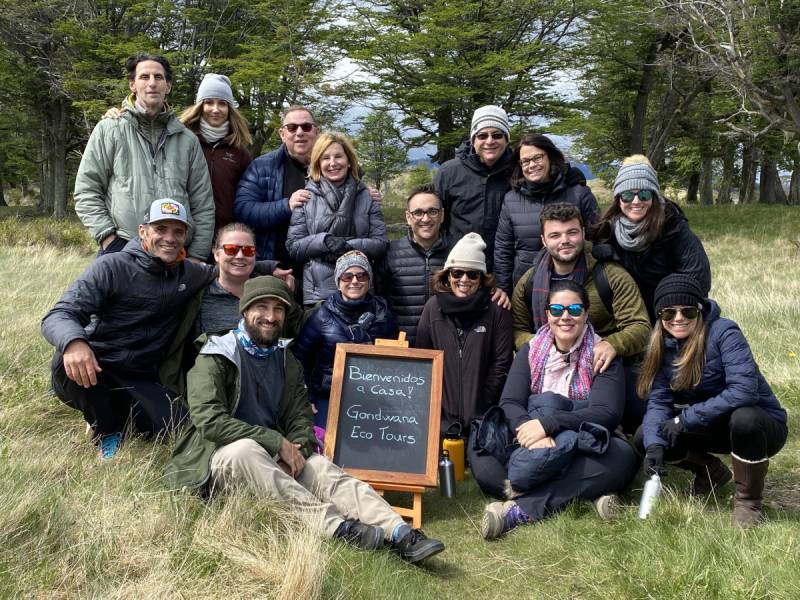Discovering Patagonia: An Unforgettable Destination
Download Travel Details >PRIVATE & SMALL GROUP TOURS TO THE WORLD'S BEST DESTINATIONS
Join Us In Argentina!

What Is The Best Time To Travel To Argentina Patagonia?
Patagonia is a unique and unforgettable destination for travelers seeking outdoor adventure, breathtaking natural beauty, and a unique amalgam of cultures. The first thing you need to realize, however, is that Patagonia is not a city! It is a geographical region shared between Chile and Argentina, located at the southernmost tip of mainland South America. So, if anyone asks you about the city of Patagonia, you’re now armed with the facts to set them straight!
But what is the best time to travel to Argentina Patagonia? The best time to visit Patagonia Argentina depends on what activities you plan to do and what weather conditions you prefer. In Argentina, peak tourist season runs from November to February – summer in the Southern Hemisphere. This is also the busiest time of the year, with prices on food, lodging, and other expenses much higher than during the off-season. September to November (spring) and March to May (fall) offer visitors cooler temperatures and fewer crowds, while June to August is the perfect time for winter enthusiasts to visit for skiing and snowboarding.
An In-Depth Look At Patagonia’s Four Seasons
If you ask a travel expert about the best time to travel to Patagonia Argentina, they will tell you that it depends on what you’re trying to get out of your trip. Weather can influence where you want to go and what you want to see, so learning more about the four seasons you’ll encounter in Patagonia is a good idea before you go!
|
Season |
Temperature |
Activities |
|
Spring (September to November) |
Temperature highs average around 16°C (60°F) and can drop to 3°C (37°F) at night – so bring plenty of layers, including thermal underwear! |
Hiking near El Chalten; enjoying the wildflowers as they bloom and create stunning landscapes; searching for wildlife, including guanacos, foxes, and birds; exploring the Argentina Lake District, including Bariloche. |
|
Summer (December to February) |
Temperatures hit 20°C (68°F), and drop to 8°C (46°F) overnight, while winds can reach up to a whopping 120 km/h (74 mph). Pack plenty of layers for when it gets cold or hot (both are a possibility!), plus a waterproof jacket and pants for outdoor adventures. |
Peak tourist season. Popular activities include: Hiking out of El Chalten; exploring Perito Moreno Glacier in Los Glaciares National Park; wildlife viewing on the Valdes Peninsula; boat tours on Lake Argentino; and horseback riding with gauchos across the pampas. |
|
Fall (March to May) |
Temperatures drop to highs of 13°C (55°F) during the day and -3°C (27°F) at night. |
Fall in Argentina’s Patagonia region is a good time to spot wildlife like pumas and various bird species; explore the hiking trails near El Chalten; go kayaking in the Lake District; or capture the stunning color changes as the landscape across the region bursts into full fall color. |
|
Winter (June to August) |
Pack your thermals and warm layers, as temperatures average around 8°C (46°F) and drop to -3°C (27°F) at night. |
Winter activities in Patagonia include: skiing and snowboarding at Cerro Catedral; exploring ice caves scattered across the region’s glaciers; snowshoeing across the pampas; unique winter wildlife viewing; and catching a glimpse of the Southern Lights in the night sky! |
The Stunning Geography of Patagonia
The best time to travel to Argentina Patagonia is important to consider when planning your trip, but it is also important to know a little bit about the region’s geography before you leave on your trip! Remember, the city of Patagonia is a misnomer! Patagonia is not a city; instead, it is a sparsely populated region known for its stunning natural landscapes. The region’s vast landscapes and diverse ecosystems include glaciers, lakes, mountains, forests, grasslands, and deserts. Some of the more noteworthy landmarks in Patagonia include:
- The Andes Mountains: Stretching for over 4,300 miles, the Andes Mountains are the longest mountain range in the world. The range extends from Venezuela to Argentina. In Patagonia, the Andes form a spectacular backdrop of snow-capped peaks, deep valleys, and crystal-clear lakes.
- Perito Moreno Glacier: Located in Los Glaciares National Park, Perito Moreno measures 19 miles long! And, unlike other glaciers, Perito Moreno is growing. In fact, it grows an estimated six feet per day! Visitors can trek across the glacier’s surface with a guide or take boat tours around the glacier to marvel at its immense size.
- Torres del Paine National Park: This park is home to some of the most iconic landscapes in Patagonia, including the soaring granite spires of the Torres del Paine mountain range, turquoise lakes, and glaciers. Although it is located in Chile, it is an easy day trip for visitors to reach from Argentina Patagonia.
- Tierra del Fuego: This archipelago at the southern tip of South America is shared by Argentina and Chile. It is known for its rugged terrain, subpolar climate, and unique flora and fauna, including penguins, sea lions, and whales. Visitors to this region have the distinct experience of visiting the “end of the world” and can even take a photograph with the official sign documenting this location!
A Few Fun Facts About Patagonia
Patagonia is truly a year-round destination, depending on what activities you want to experience! The best time to travel to Argentina Patagonia is the time that fits YOUR schedule. But, before you pack your bags, here are a few fun facts to whet your appetite for adventure!
What language do they speak in Patagonia?
The main language spoken in Patagonia is Spanish, as it is the official language of both Chile and Argentina. However, in some parts of Argentine Patagonia, Welsh is also spoken.
Why are there Welsh people in Patagonia?
Welsh people migrated to Patagonia in 1865 to protect their Welsh culture and language, which they believed were at risk in their native Wales. Over the years, the use of the Welsh language has decreased, and there has been limited contact between Wales and the Chubut Valley in Patagonia.
Why is Patagonia so famous?
Patagonia is known for its untamed and wild landscapes that attract visitors seeking a special connection with nature. But it is also the location of the most southern point on land where a human can set foot!
Do many people live in Patagonia?
Patagonia is sparsely populated. The region is home to a total population of approximately 2 million people, most of whom live in Argentina. The indigenous Tehuelche people lived in Patagonia long before the arrival of European explorers.
What is an unusual fact about Patagonia?
One unusual aspect of Patagonia is the presence of wild horses known as baguales. These horses are descendants of Andalusian horses introduced by Europeans during the 16th century.
How do you get to Patagonia?
To reach Patagonia, you can fly into various airports depending on your desired destination within the region. Some of the main airports include Punta Arenas Airport in Chile, Puerto Natales Airport in Chile, El Calafate Airport in Argentina, and Ushuaia Airport in Argentina.
What are some of the top destinations to visit in Argentina Patagonia?
Some of the more popular destinations for tourists to visit in Argentina include the Perito Moreno Glacier in Los Glaciares National Park, Ushuaia, Mount Fitz Roy, El Chalten, the Lake District, and El Calafate.
En Route To Adventure In Argentina Patagonia
Although the weather may vary by geographical region, the best time to travel to Argentina Patagonia depends entirely on where you want to visit and what you plan to see! A tour operator like Gondwana Ecotours can help you narrow down your options and plan a once-in-a-lifetime adventure with you! Book your trip today to experience the best of Patagonia’s wide-open spaces and natural beauty. Get ready for the trip of a lifetime in Patagonia.

